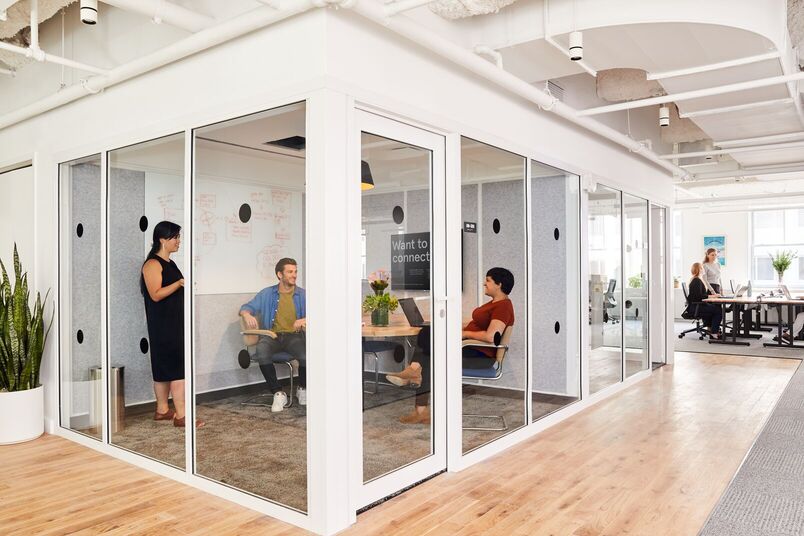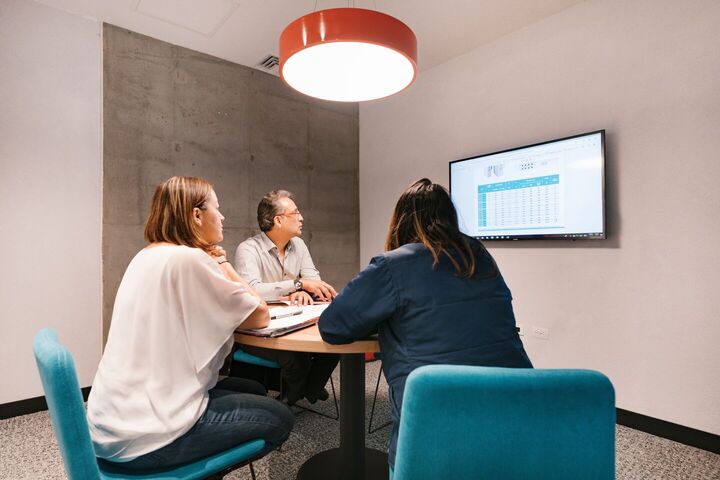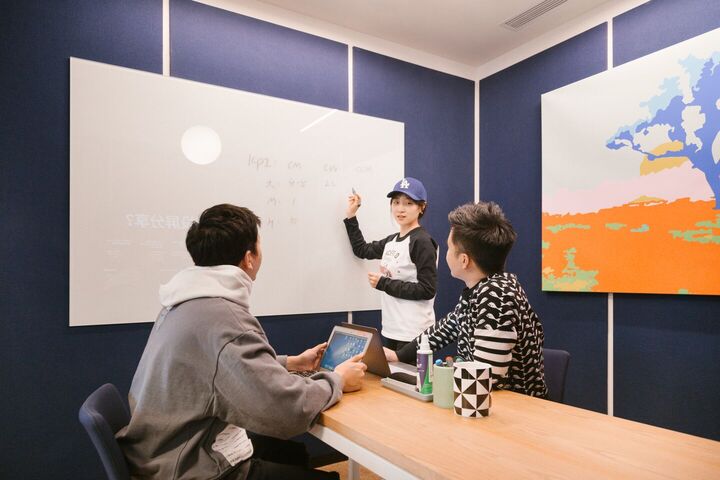We’d love to tell you that office trends come and go but in 2025, they’re here to stay. Think flex spaces, hybrid work models, wellness corners, and yes, even indoor plants—all of which reshaped the way we look at and use our workspaces. Today’s offices aren’t just spaces to work but proper ecosystems meant to foster productivity, fuel creativity, and spark connection.
Within this transformation is a deceptively simple yet powerful concept: the huddle room. Compact, informal, and endlessly versatile, huddle rooms have quietly become one of the most essential tools in the modern workspace playbook. If you haven’t embraced them yet, you’re about to see why everyone else has. Let’s dive in!
What is a huddle room
In short, a huddle room is a small, informal meeting space typically designed for groups of two to six people. While traditional conference rooms are geared toward long, scheduled meetings with formal agendas, huddle rooms are flexible, low-pressure spaces built for spontaneous collaboration.
You’ll find huddle rooms tucked into corners of open-plan offices, carved out of unused nooks, or integrated as glassed-in structures that give the sense of privacy without isolating users from their surroundings. Designs vary, but all aim to create a warm, welcoming atmosphere.
These rooms are casual but thoughtfully equipped: a whiteboard, some soundproofing, a table and a few comfortable chairs, and most importantly, a tech setup that includes a screen, camera, speakers, and easy connectivity.
Think of the huddle room as the Swiss army knife of the modern workplace. It’s where brainstorming sessions are born, quick check-ins happen, and hybrid teams feel just as present as those in the room. At roughly 100 to 250 square feet, it’s small, but it is mighty.

Why do you need a huddle room?
Picture this: you’re in the office, trying to hash something out with a couple of coworkers. You’re chatting across desks, turning screens to share ideas, trying to talk over the ambient noise of the open floor. It’s awkward, inefficient, and frankly, distracting to everyone else nearby. Sure, you could book the big conference room down the hall, but isn’t it overkill to reserve an eight-people space just to have a twenty-minute chat with two colleagues?
Enter the huddle room.
Unlike formal meeting rooms, huddle rooms are intentionally designed for moments just like these: informal, unplanned, short in duration but high in impact. They provide a dedicated space for focused discussion without the friction of scheduling logistics or the guilt of occupying a room that’s far too large.
A way to bring people and ideas together
In today’s hybrid world, where some team members might be dialing in from home, from a coworking space, or even from another city, huddle rooms offer the perfect setup. With built-in AV equipment, plug-and-play video conferencing tools, and screen-sharing capabilities, remote collaboration becomes seamless. There’s no need to fumble with cables or stress about compatibility—just connect, converse, and collaborate.
But there’s more to it than convenience.
The psychology of a huddle room encourages better communication. In a smaller space, everyone is closer, literally and figuratively. Each participant has the chance to speak, be heard, and contribute. There’s no “back of the room” in a huddle room. Decision-making becomes faster, brainstorming feels more energized, and because the environment is more relaxed, creativity tends to flow more freely.
In essence, huddle rooms respond to how we do work, not to how we’re supposed to work according to outdated office layouts.

The strategic benefits of huddle rooms
Huddle rooms aren’t just nice to have—they’re strategic assets. Here’s why businesses are investing in them:
Efficiency and speed
With no need to book in advance, teams can quickly jump into a huddle room to resolve a question, align on a plan, or conduct a focused check-in. The low barrier to entry encourages action over inertia, making teams as well as the work process itself more efficient.
Hybrid collaboration
Huddle rooms are equipped with reliable audio-visual tools which make it easy for remote workers to join in without technical hiccups. In other words, huddle rooms level the playing field for hybrid teams and ensure no one is left out of the conversation.
Space optimization
In office design, square footage is gold. Huddle rooms make smart use of small or awkwardly shaped spaces, converting them into high-functioning collaboration zones. They also reduce demand for larger meeting rooms, freeing those up for more appropriate use.
Cost efficiency
Compared to building out large boardrooms or formal conference rooms, huddle rooms are relatively inexpensive to create. They require less furniture, fewer materials, and lower ongoing maintenance, all while delivering a big impact.
Employee satisfaction
When employees have access to spaces that match the way they work, morale improves. Huddle rooms support autonomy, spontaneity, and connection, all of which are things today’s workers value highly.

How to create a huddle room that works
Designing a huddle room doesn’t have to be complicated. In fact, its success lies in its simplicity. Here’s how to bring one to life:
Start with the space you already have
Look for underutilized corners, old phone booths, small meeting rooms, or even a partitioned area in an open-plan space. The key is to ensure it is accessible but, at the same time, allows for some visual and acoustic privacy.
Keep the furniture light
Depending on the intended use, your huddle room may include just a high-top table and stools, or a small sofa with a coffee table. Stand-up meeting setups are also popular. Either way, comfort and flexibility should guide your choices. You want to make sure people feel at ease—but not too settled.
Prioritize technology
This is non-negotiable. At a minimum, your huddle room should include technology solutions like:
- A display screen or monitor
- A webcam with a wide-angle lens
- Microphones and speakers with noise-canceling capabilities
- Easy connectivity for laptops (wireless or with adapters)
- A simple interface—no IT support should be needed
Make sure the tech works for both in-person and remote participants. Test your setup thoroughly and provide clear instructions. Consider organizing a training session if need be.
Design for focus
Good lighting, basic acoustic treatment, and a clutter-free layout go a long way. Consider frosted glass or soft dividers to maintain openness while still creating a sense of enclosure. Also, a whiteboard or digital sketchpad for visual thinkers would be ideal.
Make it welcoming
Just because it’s functional doesn’t mean it has to be sterile. Add a splash of color, a few plants, or a mural wall to inject some personality. The best huddle rooms feel intentional, not like an afterthought.

Huddle rooms in the wild
Plenty of forward-thinking companies are already harnessing the power of huddle rooms. Coworking spaces, too, are leading the charge, offering huddle rooms that can be used by individuals, small teams, or hybrid groups who need quick access to private, tech-enabled meeting space.
If you’re not quite ready to build your own huddle room—or if you’re looking for flexibility without a full office fit-out—WeWork has you covered. Across many of its locations, WeWork offers small, tech-enabled meeting rooms and collaborative breakout areas that function just like huddle rooms.
With features like high-speed Wi-Fi, plug-and-play screens, and video conferencing tools, WeWork’s huddle-style spaces help you collaborate on your terms—without the overhead of building one yourself.
Wrapping up
The rise of the huddle room marks a shift in how we think about workplace design. These small, tech-savvy spaces speak to the values that define modern work: flexibility, connection, speed, and inclusivity. They support hybrid models without friction, encourage collaboration without formality, and make the best use of every square foot.
In 2025 and beyond, one thing is clear: huddle rooms are here to stay. Whether you’re a small business optimizing your floor plan or a large enterprise redesigning for the future, huddle rooms offer a high-impact, low-cost way to make your office smarter, more agile, and more human.
Big things really do happen in small rooms. Build one—or find one at WeWork—and see for yourself.




